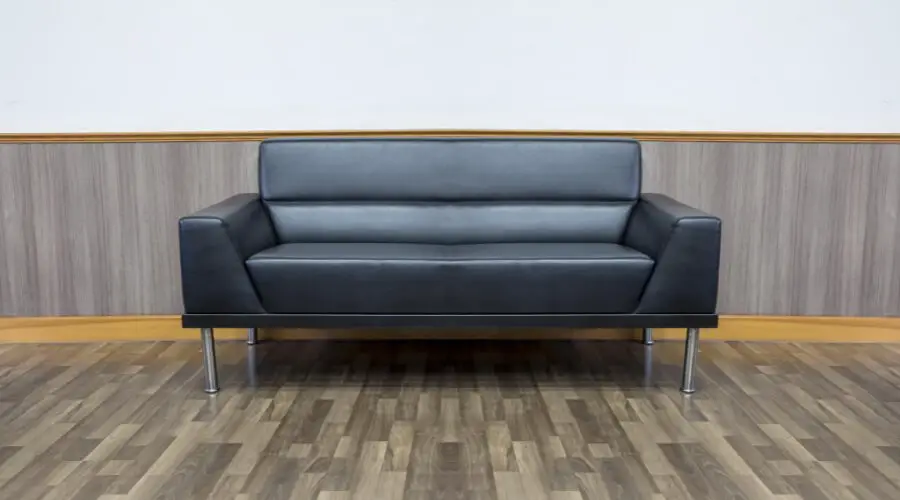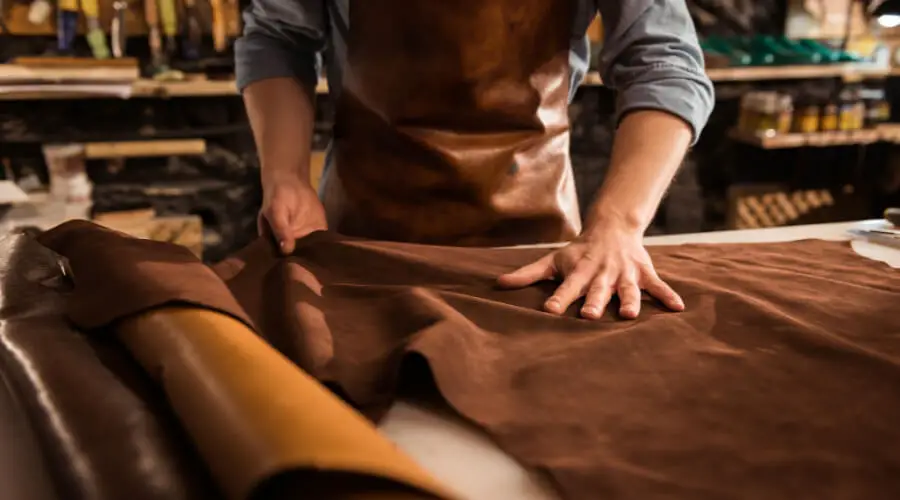Last Updated on July 13, 2023 By Emma W. Thomas
Peeling on a leather couch can occur due to several reasons. The most common causes are low-quality or bonded leather, excessive dryness, sun exposure, or improper cleaning and maintenance. To repair the peeling, first, assess the extent of the damage. If it’s minor, applying leather conditioner or moisturizer may help restore moisture and prevent further peeling. For more severe cases, using leather repair kits or seeking professional help is recommended.
Why Is My Leather Couch Peeling?

There are various reasons your leather couch has started to peel. Some of these include;
1. Your Couch Is Made Of Bonded Leather
Genuine leather is expensive, and many people do not want to spend as much on just a couch. Bonded or fake leather comes in terms of affordability; it looks and feels like genuine leather, but it is cheap and of lower quality.
When you purchase genuine leather couches, they will not crack if taken care of. The bonded leather sofas will start peeling off at some point, even if you take care of and maintain them.
2. The Leather Has Been Exposed To Extreme Weather Conditions For A While
Genuine leather can survive without cracking or peeling for many years, but it can still get damaged. Extreme sunlight and humidity can be very toxic to leather. Since it is made of animal skin, it needs to be moisturized and maintained to stay soft and elastic. Sunlight dries it up and makes it rigid, and extreme moisture makes it too soft and predisposes it to tearing.
3. Your Couch Is Made With Faux Leather.
Faux means artificial, meaning that the leather is a synthetic leathery material like vinyl, PVC, or polyurethane. Such leather is worse than bonded leather since it contains zero actual leather and hence does not have the same resilience as genuine or bonded leather.
How To Repair a Peeling Leather Couch
A leather couch can add a touch of elegance and sophistication to any living space. However, over time, the leather may start to peel, making your once-perfect couch look worn and aged. But don’t worry! With the right knowledge and a little effort, you can easily repair a peeling leather couch and restore its beauty. Here are five easy steps to help you get started.
- Step 1: Clean the Couch
Before you begin the repair process, it’s essential to clean the leather couch thoroughly. Use a mild leather cleaner or a mixture of warm water and gentle soap to remove any dirt, oil, or grime that may have accumulated on the surface. Gently wipe the couch with a soft cloth or sponge and let it dry completely before moving on to the next step.
- Step 2: Sand Away the Peeling Areas
To fix the peeling leather, you will need to sand away the damaged areas. Use a fine-grit sandpaper or an abrasive sponge to gently sand the peeling spots. Be careful not to sand too aggressively, as it may damage the underlying leather. Sand until the edges of the peeling leather are smooth and blend seamlessly with the rest of the couch.
- Step 3: Apply Leather Filler
After sanding, it’s time to apply a leather filler. Choose a filler that matches the color of your leather couch. Using a spatula or a putty knife, carefully spread a thin layer of the filler over the sanded area. Smooth it out and ensure that it covers the entire damaged section. Let it dry according to the manufacturer’s instructions.
- Step 4: Sand and Blend
Once the filler has dried, use fine-grit sandpaper to gently sand the repaired area. This will help you achieve a smooth and even texture. Blend the edges of the filler with the surrounding leather, making sure there are no visible transitions or rough spots. Wipe away any dust with a clean cloth.
- Step 5: Apply Leather Conditioner and Polish
To finish the repair process, apply a high-quality leather conditioner and polish to the entire couch. This will not only restore the moisture lost during the repair but also provide an added layer of protection. Follow the manufacturer’s instructions and use a soft cloth to apply the conditioner and polish in circular motions.
Maintaining a Repaired Leather Couch
To ensure your repaired leather couch remains in great condition, follow these essential maintenance tips:
- Keep your leather couch away from direct sunlight to avoid fading and further damage.
- Avoid placing sharp objects or rough materials on the surface that could scratch or peel the leather.
- Regularly clean the couch using a leather-specific cleaner and a soft cloth.
- Apply a leather conditioner every few months to keep the leather moisturized and supple.
- Address any spills or stains promptly and follow appropriate cleaning techniques.
What Are The Different Qualities Of Leather Available?

The quality of leather differs with how it is made and what other materials are incorporated.
There are mainly five different qualities of leather available.
1. Bonded
Bonded leather is mixed and processed with synthetic fibers that make it look like leather. It is the cheapest of the available leathers.
This leather has about 10 to 20 percent animal hide, and the remaining percentage is filled with other materials.
2. Bi-cast Leather
With the bi-cast leather, you are offered more real leather than bonded type, which is more plastic than leather. The hide used to make this is cut below the prime top layer of hide found in high-end leather.
3. Split Grain Leather
Split grain leather offers 100% leather, but the manufacturing process is so intense that it loses its natural attributes. However, the manufacturers do not use high-quality hides; they settle for lower quality to lessen the overall production cost.
4. Top Grain Leather
As the name suggests, this is leather made from the most desirable animal hide. It offers superior quality, more natural aroma, and durability, unlike the other qualities of leather.
Purchasing a couch made of top-grain leather is not cheap. The hides used to make the material are not random; the manufacturer ensures that you get what you pay for.
5. Full-Grain Leather
Among the available leather qualities in the market, this is the most exclusive and premium of them all. The leather maintains the quality of the animal hide and its prints, which can be visibly seen and felt.
A couch made from this leather is guaranteed to serve for many years with zero damage and maintains its upscale feel and smell.
Can You Repair Cracking Or Peeling Leather?
Yes, you can repair cracking leather. Below are a few steps to follow:
Step 1: Clean Your Sofa
To repair your worn-out leather couch, you start by prepping it and removing the peeled parts. Use rubbing alcohol and an abrasive pad. After that, let it dry.
Step 2: Leather Recoloring Cream
leather recoloring balm or cream is used on small cracks and small areas. The cream comes in different colors, so you can choose the color that best suits your couch.
Step 3: Purchase A Peeling Leather Sofa Repair Kit.
The recoloring cream is only a temporary fix for small areas; it does not work well for big patches. A leather repair kit is a more permanent way of fixing your leather couch.
An excellent example of a repair kit is the Fortivo leather repair kit. The kit contains leather filler that helps to cover damaged areas. It has high-quality repair adhesive that dries up fast and hides the cracks and torn areas.
The kit comes in many colors, and you have to mix them to get the color that suits your couch correctly. After that, follow the instructions that come with your kit. You can practice in a small part first before fixing your entire couch.
Can Leather Be Stopped From Peeling And Cracking?
Yes, it is possible to prevent your couch from peeling through proper maintenance and repair. Apply a good amount of leather conditioner to moisturize your sofa at least twice a year. The conditioner helps maintain the leather’s natural oils that keep it leathery and stretchy. The type of conditioner you use is not relevant as long as it is suitable for genuine leather and it does not contain chemicals that will dry it out.
Bonded or faux leather should also be moisturized to prevent premature cracking and peeling.
How Long Should A Genuine Leather Couch Last?
A low-end leather couch made of bonded or faux leather gives you 2 to 5 years of service, but it can last a bit longer with good care. On the other hand, Genuine leather lasts for over 25 years if well-maintained.
How To Tell If Your Couch Is Made Of Genuine Leather?
No one wants to buy a fake leather couch when they intend to purchase a genuine one. Below are a few ways to check if your newly purchased sofa is made of genuine leather or not:
1. Check The Appearance And Feel Of The Material
Genuine leather is made from animal skin, meaning it has a naturally rough or grainy appearance. It is common to see natural hide markings on your couch, particularly with full-grain leather, which is considered the best. The sofa should also feel bumpy to the touch. Fake leather is smooth all around because it is artificial. Animals have fat deposits on their skins, and this causes bumps.
2. Rough Or Uneven Edges
It is common to see the edges of your couch being uneven and rough; this symbolizes the joining of two or more hides. Smooth and even edges indicate that the leather is not made of natural animal skin. No animal hide is big enough to sit on an entire couch.
3. Rich Natural Leather Aroma
Fake leather cannot have the same scent as actual leather. Being that bonded and faux leather is made using many chemicals, they do not have the natural leather scent that animal skins produce.
Tips For Maintaining Genuine Leather
Here are three tips you can continuously implement to ensure that your leather sofa gives you enough service:
1. Buff Out The Scratches. It is natural for your couch to get scratched over time. Buffing out the scratches with a soft cloth and using moisturizer ensures peeling and cracking do not happen.
2. Position Your Couch In A Favorable Spot. Sunlight is not always suitable for leather. It can dry it up and cause damage. Placing your sofa away from direct sunlight, heaters, and fireplaces can help maintain it.
3. Regular Conditioning. Using protection creams to keep your leather soft and elastic is a practice you should never tire off.
Final Thoughts
Genuine, faux, or bonded leather can all crack when neglected. Moisturizing your leather couch no matter its quality ensures that you at least enjoy using it for a while without it cracking and peeling off. Damaged leather is repairable, so there is no need to buy a new couch when your current one gets damaged.
References:
https://furnitureblog.simplicitysofas.com/blog/why-is-the-leather-on-my-sofa-peeling/
https://www.goldeagle.com/tips-tools/why-does-leather-peel/
Emma is a graduate of Domestic Science or Family and Consumer Sciences (Home Economics) from the University of Wisconsin. She has 7 years of experience Working with the strategic section of BestBuy and now writing full-time for Homeeon.
From Managing the Home, Interiors, Cleaning, and Exteriors to Gardening and everything about Making A Home Liveable – is her passion and this Homeeon is the result of this.
Emma loves decorating her home with the best stuff found online. She cares about quality over anything and writes reviews about them here in Homeeon. Get in touch with her over Pinterest.
Keep reading her blogs.

